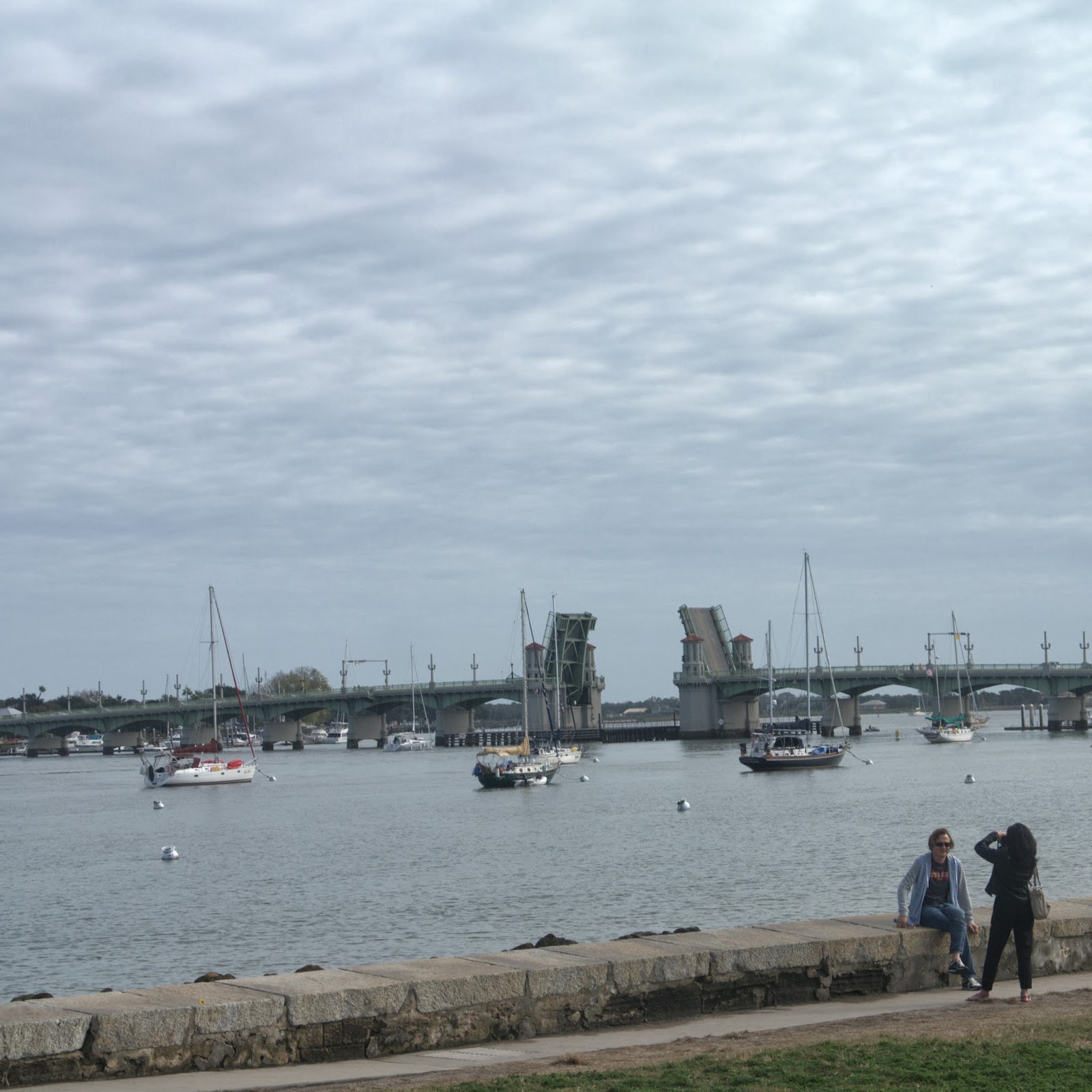We stayed at Anastasia State Recreation Area, which is a
1,600 acre Florida State Park located on
a peninsula on the Atlantic coast of Anastasia Island across Matanzas Bay from
downtown St. Augustine. You don’t want to get caught on that draw bridge during
rush hour.
The park has a variety of wildlife, birds and plants in a setting of beaches, tidal salt marsh, marine and upland hammock.
The park has a variety of wildlife, birds and plants in a setting of beaches, tidal salt marsh, marine and upland hammock.
There were many activities including bird and wildlife watching,
camping, fishing, sun bathing, surfing, sail boarding, swimming and kayaking. Amenities
include a campground and nature trails, and the park is unique in being the
site of a quarry from which the coquina stone used in the construction of the
Castillo de San Marcos Fort in St. Augustine was mined.
 |
| Arch made out of coquina stone |
In the current city of St. Augustine is the Ponce de León
Hotel. It is a fashionable hotel built by millionaire developer and Standard
Oil co-founder Henry M. Flagler. The Hotel Ponce de Leon was designed in the Spanish
Renaissance style. It was constructed entirely of poured concrete, using the
local coquina stone as aggregate. The original hotel also was wired for
electricity. The power being provided by D.C. generators supplied by Flagler's
friend, Thomas Edison.
On our walk about town we saw several building including the
Fort built of coquina stone. It is a sedimentary rock that is composed of fragmented
sea shells. For a sediment to be considered to be a coquina, the average size
of the particles composing it should be 1/2 inch or greater. Coquina can vary
in hardness from poorly to moderately-cemented. The term "coquina" is
derived from the Spanish word for cockleshells or shellfish. Over the century
with environment settings and strong waves and currents resulted in the
vigorous fracturing of shells, composites were developed. Well-developed beds of coquina were readily
available from a nearby quarry, whereas wood was not as available or as strong,
so coquina was used for building materials by the Spanish.
We used the local Lighthouse for our navigation around the town;
giving meaning to the saying ‘the lighthouse will navigate by land and sea’.
 We'll never forget the Christmas Lights in St. Augustine, near
the river and bay. Florida’s historic
coast was the setting for this year’s 20th year of St. Augustine’s Night of
Lights. During the Nights of Lights, St. Augustine is aglow with holiday magic.
From the ground to the rooftops on every tree and bush the sight is surreal.
We'll never forget the Christmas Lights in St. Augustine, near
the river and bay. Florida’s historic
coast was the setting for this year’s 20th year of St. Augustine’s Night of
Lights. During the Nights of Lights, St. Augustine is aglow with holiday magic.
From the ground to the rooftops on every tree and bush the sight is surreal.National Geographic, in 2011 & 2012, listed them as one of the ten best holiday lighting displays in the world! St. Augustine’s Nights of Lights features millions of tiny white lights that create a magical atmosphere in the nation’s oldest city. Tracing its origins to the Spanish tradition of displaying a white candle in the window during the Christmas holidays, the spectacular lighting reflects the city’s 448 year history. The illuminated beautiful setting will always be one of our lasting holiday memories.
In this smaller town we passed on the bus tours, but parking
was not easy. The Ripley’s Believe it or Not Museum parking lot was free and easy to access.
Robert Ripley was a frequent visitor to St. Augustine and stayed at Castle
Warden Inn often, however he did not create the museum. He died in 1949 and a
year after his death, the Castle Warden was purchased to be the ideal, 

 |
| My dear wife making googly eyes at Captain Jack Sparrow! |
uniquely glamorous building to house his collections. The museum includes weird sights
for family members of all ages. This collection included real shrunken human
heads that Ripley collected on his trips to South America. He was also
interested in pirates. The Peel Car which is the world’s smallest production
car was on display. It was this young man’s dream to marvel at the largest
operational erector set Ferris wheel.
Ripley, over the years was given various gifts from the famousto the
common man and they are all on display. You can even take a picture of yourself
with “The Lizard Man”, a two headed calf or various unusually formed animals. On
display were pictures of the tallest and shortest and the heaviest men. There
were over 800 unique exhibits, artifacts, art work on exhibition that amazed us. I can see why they made a movie of his
collection back in the 80’s.
Happy Travels,
George (with Peggy & Coco)






No comments:
Post a Comment